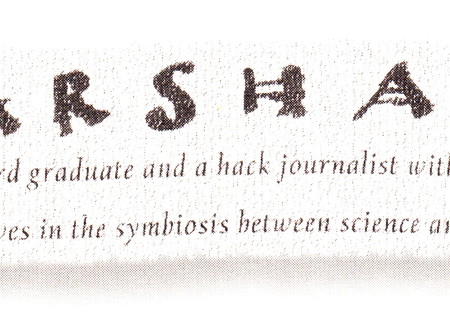Mediamatic conducted a written poll into the use of old and new media in the daily practice of artists, writers and businesspeople. We silently hoped we might be able to detect some possible revaluation of the old media surrounding us. That we might therefore construct an idea of how interaction between the present and the past, between the past and a future, might take shape in mutually-enhancing scenarios, maybe illustrated by means of so-called MediaScapes.
The results of the questionnaire on the use of old and new media, possibilities and impossibilities, can be read on the following pages.
The road to the MediaScape has obviously not been an easy one. Whatever we may have expected, the challenges of the modern media have evidently eclipsed interest in the older networks. Our thoughts were somewhat focused on the question of how people handle the old media despite the claims of the new, and whether an unexpected old media revival might possibly be observed.
A naive expectation. Everyday contact with the older media is part of a nostalgic portion of the mind which is excluded from our daily experiences. The use of these media is so intimate and familiar that it happens without a thought. This situation has created an abstract, unconsciously functioning enclave between nostalgia and practice. Only if a critical boundary is crossed, and this abstract area consigned to nostalgia, is conscious reflection again possible.
Then there is suddenly an addiction to old Bakelite radios, or a pronounced love for the primitive transistor. This produces the image of a sensibility which has still not been displaced by new media, which has not yet achieved museum status, and has thus become harmless: an area where the old media can still function, alive, without having acquired cult status.
We are still just learning to live with the new media. The fountain pen, the drawing pen, the eraser, each has been given a place on the program menus, and finally the Notepad has returned to us what the computer had deprived us of: the pencil.
The software programmers have a sophisticated grasp of the thinking process and of the fantasy that keeps our minds lively. As the X-ray shows a transparent view of our skulls, the diverse programs give us a vivid view of the vibrations and the wave movements of our thoughts. The processes in our minds are finally shown to have adopted a more or less regular pattern!
But how does music from a computer differ from the sounds that Beethoven conjured up in his mind? What are the differences in abstraction between the mind of Stanley Morrison and the Laser Writer? Did Seurat feel something of the warmth that one experiences behind the computer when running PhotoShop, or would he as a cool calculator have felt more at home at Mathematica? What is the difference between Inspiration™ and real inspiration?
I think I'm just going to go and read a good book.
Next to product comparisons which assure us of a future which is constantly renewing itself, reflections on the acquisition of the past and the place the older media occupy in our minds might at first glance be a less than stimulating proposition.

-

Mediamatic Magazine Vol. 6#2/3 1 Jan 1991
Fawcett
Over-Stressed
Brian Fawcett is a Canadian writer and journalist. The author of Cambodia and the Public Eye, two pessimistic books about media and society, that in their form redefine the book as a medium itself.
-

Mediamatic Magazine Vol. 6#2/3 Bert Mulder 1 Jan 1991
Media, Information & Me
Difference
Bert Mulder is a pioneer in computer-supported cooperative work. He works at Veronica Broadcasting Company and is currently learning Chinese in order to read Confucius.
-

Mediamatic Magazine Vol. 6#2/3 Alfred Birnbaum 1 Jan 1991
Birnbaum
Humour
Alfred Birnbaum is an American telematic nomad and polyglot, who works as a writer, translator and artist. Most of the time he hovers around Asia.
-

Mediamatic Magazine Vol. 6#2/3 Joost Niemöller 1 Jan 1991
Niemöller
Revenge
Joost Niemöller is the soft-voiced, mild-mannered author of the novel Revenge. He is currently writer in residence at the University of Texas, Austin
-

Mediamatic Magazine Vol. 6#2/3 Remko Scha 1 Jan 1991
Scha
Computer – Language
Remko Scha is a Dutch artist and scientist who is experimenting with speech and computers.
-

Mediamatic Magazine Vol. 6#2/3 Brian Reynolds 1 Jan 1991
Reynolds
Rain
Brian Reynolds has been asked by Gruppo Feruzzi to turn his farm into the most technologically sophisticated in England.
-

Mediamatic Magazine Vol. 6#2/3 Pim Fortuyn 1 Jan 1991
Fortuyn
Well gestured
Prof W.S.P.Fortuyn was responsible for the free public transport network for students in Holland. Prof. Fortuyn was a converted Marxist who called himself an adviser in political and strategic...
-

Mediamatic Magazine Vol. 6#2/3 Anne-Mie van Kerckhoven 1 Jan 1991
Kerckhoven
Dream
Annemie van Kerckhoven is a Belgian artist who wears her politics on her panties.
-

Mediamatic Magazine Vol. 6#2/3 Koos Dalstra 1 Jan 1991
Dalstra
Deceit
Koos Dalstra is a Friesian poet and a cheat.
-

Mediamatic Magazine Vol. 6#2/3 Jules Marshall 1 Jan 1991
Marshall
Death
Jules Marshall is an Osford graduate and a hack journalist wih ideas above his station. He believes in the symbiosis between science and art.
-

Mediamatic Magazine Vol. 6#2/3 Adilkno 1 Jan 1991
ADILKNO
Academy
ADILKNO is the Dutch society for the advancement of illegal knowledge.